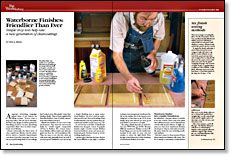Waterborne Finishes: Friendlier Than Ever
Simple shop tests help rate a new generation of clearcoatings
Synopsis: Waterborne finishes are nontoxic, adhere well, raise the grain less than they used to, and are easy to use, dry fast, clean up with water and level out well. Finishing chemist Chris A. Minick evaluates 15 popular brands of gloss and explains how to choose a finish. He discusses their chemistry, explains how they work, and offers a chart comparing how they all did in terms of adhesion over oil stain, stain, heat, and solvent resistance, sanding, appearance, and best applicator. Side information is provided on finish testing methods and on solving common finish problems.
A cigarette advertising campaign gained fame, if not fortune, by telling women, “You’ve come a long way, baby.” The ads are in bad taste. But that corny slogan would be perfect for describing products I’m sure advertising copywriters didn’t have in mind—waterborne wood finishes.
Almost universally, the latest wave of clear, waterborne finishes shows a dramatic improvement over those of just five years ago. Gone are the poor-performing, hard-to-use coatings that looked more like plastic wrap than furniture finish. They’ve been replaced by friendlier finishes, some of which out-perform nitrocellulose lacquer.
Waterborne finishes are not toxic to the environment. They meet the most recent limits for volatile organic compounds (VOCs) in finishes. The newest waterborne finishes adhere better and raise the grain less than the old formulations did. They are easy to use, dry fast, clean up with water and, generally, level out well. If you have good ventilation, you can set up a simple finishing area to spray waterborne finishes. You don’t need an explosion-proof booth. If you’re brushing, keep in mind that the coats dry quicker than solvent-based varnish.
To see how the new field of waterborne finishes has changed, I chose 15 popular brands—eight over-the-counter finishes found at hardware stores and seven professional-grade finishes found at woodworking supply stores.
I picked gloss finishes because they’re the most difficult to get right. I couldn’t evaluate every transparent waterborne finish on the market, but if the brand you’re using isn’t on the chart on pp. 50-51, some simple shop tests will tell you how good your finish is.
Choosing a finish depends on many factors. Because different waterborne finishes excel at different things, you can use the results summarized in the chart (or your own test results) to select the right finish. First, though, a brief discussion of the chemistry of waterborne finishes is in order.
Waterborne finishes have complex formulations
By definition, a lacquer always is soluble in its own solvent. That’s why even dried nitrocellulose lacquer can be cleaned from a brush with lacquer thinner. It might surprise you that most waterborne finishes are lacquers. They’re sold under every finish name under the sun, including acrylic and urethane.
But don’t expect to clean up any of these dried waterborne finishes with water. Water is merely a convenient, non-hazardous carrier liquid that transports the resin from the can to the work.
From Fine Woodworking #115
For the full article, download the PDF below:
Fine Woodworking Recommended Products

Estwing Dead-Blow Mallet

Bahco 6-Inch Card Scraper

Odie's Oil























Log in or create an account to post a comment.
Sign up Log in